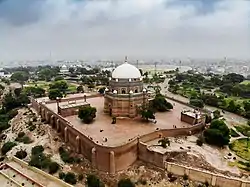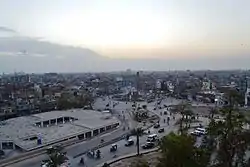Multan
ضِلع مُلتان | |
|---|---|
  | |
 Multan District highlighted within Punjab Province | |
| Coordinates: 29°56′N 71°22′E / 29.933°N 71.367°E | |
| Country | Pakistan |
| Province | Punjab |
| Division | Multan |
| Headquarters | Multan |
| Number of Tehsils | 4 |
| Government | |
| • Type | District Administration |
| • Mayor | None (vacant) |
| • Deputy Commissioner | Mudasir Riaz Malik (BPS-19 PAS) |
| • District Police Officer | Mansoorul Haq Rana (BPS-19 PSP) |
| Area | |
| • Total | 3,720 km2 (1,440 sq mi) |
| Population | |
| • Total | 5,362,305 |
| • Density | 1,400/km2 (3,700/sq mi) |
| Time zone | UTC+5 (PKT) |
| Languages | Saraiki, Punjabi, Urdu |
| Website | multan |
Multan District (Urdu: ضِلع مُلتان), is a district in the province of Punjab, Pakistan. Its capital is the city of Multan. The district has a population of 4.75 million (as of 2017) and an area of 3,720 square kilometres. The district consists of tehsils of Multan saddar, Multan city, Jalalpur Pirwala and Shujabad.[3]
Vehari, Khanewal and Lodhran were Tehsils of Multan district. Vehari was made separate district in 1976. Khanewal was cut off from Multan and made a separate district in 1985. Lodhran was split off as a separate district from Multan in 1991.[4]
Location
Multan District is surrounded by the Khanewal to the North and North East, the Vehari to the East and Lodhran to the South. The Chenab River passes on its Western side, across which lies Muzaffargarh. Bahawalpur district is to the south across the Sutlej.
Demographics
| Year | Pop. | ±% p.a. |
|---|---|---|
| 1951 | 725,131 | — |
| 1961 | 983,815 | +3.10% |
| 1972 | 1,506,223 | +3.95% |
| 1981 | 1,970,075 | +3.03% |
| 1998 | 3,116,851 | +2.74% |
| 2017 | 4,746,166 | +2.24% |
| 2023 | 5,362,305 | +2.06% |
| Sources:[5] | ||
At the time of the 2017 census, Multan district had 758,832 households and a population of 4,746,166. Multan had a sex ratio of 949 females per 1000 males and a literacy rate of 55.36% - 65.17% for males and 45.54% for females. 2,058,920 (43.38%) lived in urban areas. 1,293,514 (27.25%) were under 10 years of age.[6] In 2023, the district had 887,304 households and a population of 5,362,305.[2]
| Religion | Population (1941)[7]: 62–63 | Percentage (1941) | Population (2017) | Percentage (2017) |
|---|---|---|---|---|
| Islam |
428,659 | 79.4% | 4,716,267 | 99.37% |
| Hinduism |
101,985 | 18.89% | 2,366 | 0.05% |
| Sikhism |
6,802 | 1.26% | — | — |
| Christianity |
1,012 | 0.19% | 25,693 | 0.54% |
| Ahmadi | — | — | 1,665 | 0.04% |
| Others [lower-alpha 3] | 1,428 | 0.26% | 175 | 0% |
| Total Population | 539,886 | 100% | 4,746,166 | 100% |
At the time of the 2017 census, 64.41% of the population spoke Saraiki, 17.77% Punjabi and 16.20% Urdu as their first language.[6]
Tehsils
Notes
- ↑ 1941 figures are for Multan and Shujabad tehsils of Multan District, which roughly corresponds to present-day Multan district. Historic district borders may not be an exact match in the present-day due to various bifurcations to district borders — which since created new districts — throughout the historic Punjab Province region during the post-independence era that have taken into account population increases.
- ↑ 1941 census: Including Ad-Dharmis
- ↑ Including Jainism, Buddhism, Zoroastrianism, Judaism, or not stated
References
- ↑ "Multan District at Glance". Population Census Organization, Government of Pakistan. Archived from the original on 25 April 2012. Retrieved 28 June 2011.
- 1 2 "TABLE 1 : HOUSEHOLDS, POPULATION, HOUSEHOLD SIZE AND ANNUAL GROWTH RATE" (PDF). www.pbscensus.gov.pk. Pakistan Bureau of Statistics. 2023.
- ↑ "District Profile | Multan". multan.punjab.gov.pk. Retrieved 4 October 2022.
- ↑ "Our History | Multan". multan.punjab.gov.pk. Retrieved 4 October 2022.
- ↑ "Population by administrative units 1951-1998" (PDF). Pakistan Bureau of Statistics.
- 1 2 3 4 "District Wise Results / Tables (Census - 2017)". www.pbscensus.gov.pk. Pakistan Bureau of Statistics.
- ↑ "CENSUS OF INDIA, 1941 VOLUME VI PUNJAB PROVINCE". Retrieved 21 July 2022.

